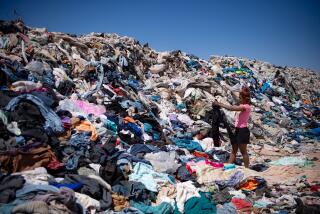Disposables May Be Here to Stay : From Dishes to Diapers, the Consumer Is Voting Yes
- Share via
We use them for eating, drinking and swaddling baby bottoms. As a nation, we spend billions of dollars for disposable items from razors to rocket launchers, use them, then throw them away. Yet some people consider all the disposables a boon to mankind.
Consider some of what goes into the trash each year:
--45 billion paper and plastic cups.
--21 billion plastic containers, dishes and bowls.
--15 billion paper plates.
--18 billion plastic lids.
--16 billion diapers.
--2 billion razors and razor blades.
--1.6 billion pens.
--348 million lighters.
All this disposing adds up. It is estimated that each of us throws out 3 to 5 pounds of things disposable each day--more than half a ton of garbage per person per annum.
Home and Office
“Most people in the industry estimate 160 million to 180 million tons are thrown out at home,” said Joe Salimando, editor of Waste Age, a magazine for the landfill industry. “That doesn’t count what is thrown out at the office.”
Not everyone thinks such waste is reprehensible.
Stanley Marcus, chairman emeritus of Neiman-Marcus stores, recently ranked throwaway pens, razors, lighters, diapers and chemically soaked towelettes among the best 25 consumer products of the last quarter century.
“Felt-tip pens decreased the cost of the writing instrument while vastly improving its performance,” he wrote in Consumers Digest magazine, adding that “disposable diapers speak for themselves.”
Medical and Military
Some disposables are specialized. The medical profession relies on disposable syringes, gloves, gowns and scalpels. The Army is a notorious disposer, leaving behind everything from bullet cartridges to rocket launchers to pilotless aircraft on the battlefield.
The military is experimenting with a new secret weapon: the paper plate. Various commands are testing brown paper plates and plastic utensils as replacements for the metal mess kits long used by soldiers.
The proposed mess system would use foods easily heated in front-line situations and serve them up on disposable dishes.
“They just pass out the paper plates and chow’s ready for everybody,” said Harvey Keene, a spokesman at the U.S. Army’s Natick, Mass., Research and Development Center.
Mankind’s disposable habit goes back to prehistory. Recently, archeologists found 5,000-year-old clay cups and eating utensils in a dig at the ancient city of Terka, near Ashara, Syria.
“We find these by the thousands in small areas,” said Giorgio Buccellati, an archeology professor at UCLA. “Since there are so many, so cheaply made, we assume they were easily discarded and replaced with others.”
Gillette’s Inspiration
And history is marked with tales of fortunes built on disposable notions.
In the summer of 1895, King C. Gillette, a 40-year-old traveling salesman and part-time inventor, stood in front of a mirror with a lathered face and a dull razor and had a revelation: a razor that used disposable blades.
“I have got it, our fortune is made,” he wrote his wife. His words were prophetic. Gillette took his idea and a $5,000 investment and built it into a company that last year sold $2.2 billion in disposable razors, pens, lighters and other sundries.
Disposables have grown to acquire megastatus in modern America, where an estimated $2 billion is spent on plastic and paper plates alone each year. And, of course, there is the $2.7-billion diaper industry.
So protective was Procter & Gamble about its Luvs didy empire that it went to court, winning a $2.3-million judgment against Weyerhaeuser Co. for infringing on its disposable diaper patent.
Retooling Production
P&G; recently spent more than half a billion dollars retooling a production line for its other disposable brand, Pampers, to make diapers that absorb more and leak less.
“It was done to offer worldwide the technological improvements in our diapers,” said Sydney McHugh, a company spokeswoman.
The diapers have been a bane to some environmentalists who complain that the plastic bottoms remain moldering in landfills years after they are thrown away. But when an Oregon legislator tried to introduce a bill banning the nappies, colleagues cited it as the silliest bill of the 1979 session.
Some people make their living defending disposables.
“Sanitation, convenience, safety, economy, space savings” are some of the factors rattled off by Joseph Bow, executive vice president of the Single Service Institute, a trade organization for plastic and paper cups and plates, when asked about the advantages of such disposable foodware.
Bow said disposables have become ingrained in the culture.
More to Read
Inside the business of entertainment
The Wide Shot brings you news, analysis and insights on everything from streaming wars to production — and what it all means for the future.
You may occasionally receive promotional content from the Los Angeles Times.










